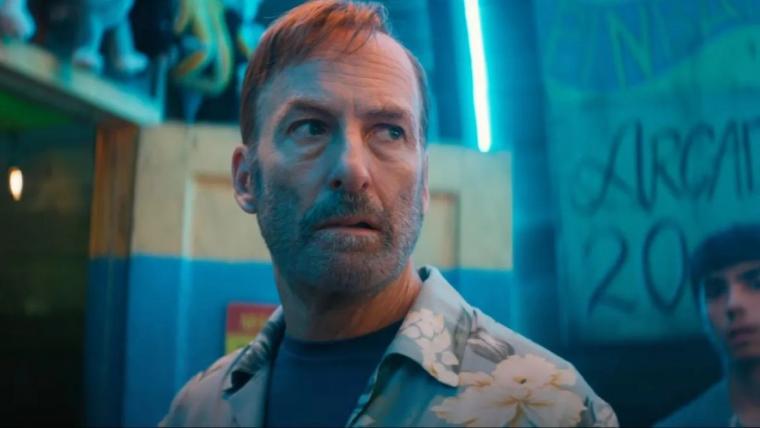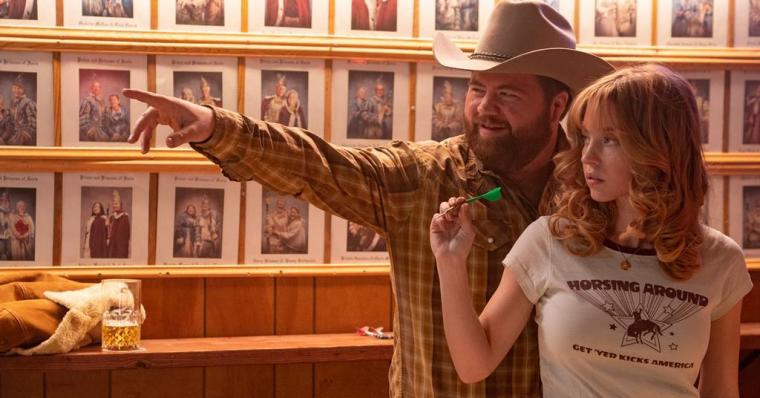
Bob Odenkirk in Nobody 2
NOBODY 2
Because I'm predisposed to love Bob Odenkirk in anything, it says something about the man's unique charisma that I even managed to like him in Nobody 2, a comedic action thriller that falls apart in nearly every conceivable way.
The movie's badness is a shame for a number of reasons, not least of them being that its 2021 predecessor – which introduced us to Odenkirk's average-Joe super-assassin Hutch Mansell – was an unexpected, grisly blast. Yet director Timo Tjahjanto's followup also boasts roles for returning players Connie Nielsen, RZA, and peerless crackpot Christopher Lloyd. Joining the fray are Colin Hanks, character-actor great John Ortiz, and, as a sleekly dressed and coifed psycho, Sharon Stone. The ultra-violent, laugh-minded finale essentially imagines what would've transpired had John Rambo fortified and booby-trapped Wally World. And the whole shebang, end credits included, wraps up in a tidy under-90 minutes. How did this thing go so unfailingly, dismally wrong?
Mostly, I would suggest, through repetition, redundancy, and stupidity. You can understand screenwriters Derek Kolstad and Aaron Rabin wanting to essentially replicate the original film's arc, with suburban shlub Hutch again forced to kill a veritable hornet's nest of crime bosses and hired goons. And you can see the inherent appeal of repeating certain sight gags, including the pre-title-card interrogation-room intro and Hutch's habit of belatedly hauling trash to the curb on pick-up day. But did we need a full reprise of the first film's scene in which Hutch battles thugs on a moving vehicle, gets thrown off, and climbs back on the moving vehicle – this time a boat, as opposed to a bus – so the brutality can continue? (At least the previous installment didn't add this movie's dopey joke of the driver and fellow passengers being too distracted to notice the gory mayhem behind them.) Did we need a replay of Hutch setting a mountain of cash on fire, Dark Knight-style, to justify the chief lunatic's revenge? Did we need Nielsen, as Hutch's wife Becca, giving yet another speech about how she'll support her hubby's über-violent methods for the sake of the children?

Although nothing really comes of it, I dug the conceit that found Hutch now indebted to the mob to the tune of $30 million that has to be paid off through contract killings. And there's certainly comic potential in the vengeful carnage perpetrated, while the Mansells are on a rare family vacation, in a tacky theme-park community that houses Hutch's few precious (positive) childhood memories. Otherwise, though, watching Nobody 2 is just like watching Nobody 1 again – it's Nobody, Too! – except without the inventive action choreography and novel kick of watching Bob Odenkirk unleash his inner Liam Neeson.
Plus, not for nothing, this sequel is a lot dumber than the original. Over the course of not-quite-an-hour-and-a-half, I routinely rolled my eyes at the clichés and inanities: the local teen bully (Lucius Hoyos) who of course hassles Hutch's teen son (Gage Munroe) for reasons passing understanding; the local law enforcement who are of course under the thumb of Stone's sociopathic crime lord; the lengthy montage demonstrating exactly where Hutch is planting his theme-park gotchas so we can be utterly unsurprised when the traps are sprung. Because, let's face it, none of us expected much from the 2021 Nobody, it's hardly an unforgivable affront that this new one is so weak. It's still a bummer, particularly if you only want good things for Odenkirk – though to his considerable credit, he never treats his duties here like the hack work it very much is.
With the exception of Ortiz, who seems perpetually perfectly calibrated, most of Tjahjanto's name actors are caught working way too hard; Hanks and Stone, respectively playing “shifty” and “psychotic,” attack those descriptors with so much misguided force that their performances are borderline-embarrassing. By contrast, Lloyd is barely working at all. He's so firmly entrenched as America's Favorite Eccentric Grandpa that he can make his mark simply by smiling and occasionally speaking. (Playing Hutch's and RZA's retired-FBI dad, Lloyd opts to remove his sunglasses precisely once.) Yet Odenkirk, bless him, is fully invested, playing the stakes behind ludicrous situations when no one else is, and absolutely selling the frustrated exhaustion and anger of an undemanding family man who just needs a freaking vacation, dammit. Odenkirk, here, is fierce and funny and even a little tragic, and if his latest starring vehicle came at all close to matching what he gives it, it might've been something special. Instead, it's simply a lesser Nobody, if one with the decency to showcase a genuine Somebody.

AMERICANA
In the trailer for Tony Tost's writing/directing feature debut, one of the review quotes states that “Americana is like an early Tarantino movie.” That's certainly true – but are those words meant as praise or damnation? To be sure, this modern Western that finds a group of South Dakota lowlifes, hustlers, indigenous warriors, and relative innocents seeking possession of a Native American “ghost shirt” worth some $500,000 is Quentin-adjacent in terms of its loquaciousness, bursts of unexpected violence, fractured chronology, and obscure pop-culture references. (Jim Jarmusch's 1999 crime drama Ghost Dog: The Way of the Samurai gets a nice shout-out, as does its star Forest Whitaker, and I can't recall the last movie that scored a laugh through a Wilford Brimley mention.) Yet Americana is also so early-Tarantino – as well as early-Coen-brothers circa Blood Simple – that Tost's indie veers dangerously close to self-consciousness and preciousness, which probably aren't desired destinations for a movie that touches on cultural appropriation, war injuries, patricide, forced sexual servitude, and exactly who owns the rights to American artifacts. Then again, maybe we're just meant to laugh at it all. Early Tarantino likely would have. Come to think of it, present Tarantino likely would, too.
In any event, Tost's debut is a pretty good time. The narrative is just twisty and unpredictable enough to keep you guessing about which of its oddball characters, if any, will survive the inevitable bloodbath and/or score the half-million, and Tost's actors are first-rate, the cast so stacked that even performance genius Harriet Sansom Harris shows up for about 30 seconds. In no particular order, which is just how the opening scenes appear to have been presented, we're treated to: pop singer Halsey as a firecracker survivor of domestic abuse; Eric Dane as her thuggish partner; Gavin Maddox Bergman as her pre-teen son (a white kid who believes he's the reincarnated Sitting Bull); Zahn McClarnon as a Native American activist (one who can't believe this white kid believes he's the reincarnated Sitting Bull); Simon Rex as a nattily attired entrepreneur; Toby Huss as this tiny South Dakota burg's last remaining aesthete (his “t”-heavy diction on “ghost shirt” is priceless); Paul Walter Hauser as a shy, adorable veteran aching for love; and Sydney Sweeney, under a convincing wig and freckles, as a sweet, stammering professional waitress and wannabe country-music star. Collectively, they make for terrific company over Americana's never-dull 107 minutes, and if the movie sometimes feels like recycled goods, ant least those goods were made from superior product.

SHIN GODZILLA
My biggest complaints with Shin Godzilla, the 2016 monster smash that's now getting a national 4K re-release, are that I'm not Japanese, and am not fluent in Japanese. These issues are hardly the movie's fault. But while I wanted to enjoy myself during the movie's extended opener, during which scores of government figures kept comically passing the buck regarding who was responsible for handling the unprovoked kaiju attack, it was hard to fully engage with the experience, considering how busy I was trying to keep up with the subtitles.
I don't think it's an exaggeration to say that, over the course of 20-odd minutes, directors Hideaki Anno (who wrote the script) and Shinji Higuchi introduce us to more than four dozen characters. Some, such as Prime Minister Hideki Akasaka (Yutaka Takenouchi) and Deputy Chief Cabinet Secretary Rando Yaguchi (Hiroki Hasegawa), are of central importance. Others, including U.S. presidential envoy Kayoco Anne Patterson (Satomi Patterson) and high-ranking members of Akasaka's cabinet, are of moderate significance. Most of them are only there to deliver a line or two. And every time a new figure enters the scene, we Western audiences are confronted with subtitles and surtitles: at the screen's top, we get the translated dialogue, and at its bottom, we get the characters' names and specific positions. (On occasion, when these officials are speaking from outside the government, we're also told what buildings they're in.)

Even though, in my advanced age, I can still follow foreign-language releases as well as the next guy, it finally became impossible to make out both sets of translations, and I opted to only follow the dialogue. But even then Anno and Higuchi made it rough, because this thing is edited like Ford v Ferrari or Whiplash, the latter a feeling I'm now intimately familiar with. Unless our titular creature, in one of his numerous forms, is laying waste to Tokyo and other urban centers, the shots in Shin Godzilla rarely last longer than three seconds – a great boon to the movie's pace, but hell on any non-Japanese speaker trying to follow the story's particulars. And I really wanted to! There were clearly hilarious things being said and (not) done as the Godzilla Problem was foisted on one beleaguered governmental agency after another, and after the glorious emotionalism of 2023's Godzilla Minus One, I was jazzed for a demolition-fueled epic that suggested Howard Hawks' take on a Toho adventure. Maybe it'll play better if/when I catch the film on home video or streaming, taking full advantage of my remote's pause button.
All that said being said, Shin Godzilla still plays awfully darned well. Even if you're not entirely certain about what's happening with the film's humans – or aware that the film's inspiration came from Japan's 2011 onslaught of earthquake, tsunami, and nuclear disasters – there's urgency, imperative, and plenty of humor in the performances and the quick cuts of editors Atsuki Satō and Hideaki Anno. The visual effects, though not quite as artful as the Oscar-winning ones employed seven years later, are frequent knockouts, while the sound-effect roars in this 4K restoration are appropriately seat-shaking. Anno's and Higuchi's compositions vacillate admirably between tight closeups and impressively wide vistas; in a handful of sequences, you really have to look to detect where the demolition is coming from. As for Godzilla, who's most frequently referred to with the Japanese pronunciation “Gojira,” he/she/it is truly something. The last of its evolutions resembles the scaly, fire-spewing, laser-blasting horror we're familiar with. But getting to it involves a delightful de-escalation of silliness, and I may have most appreciated the being's first incarnation, when it resembled nothing so much as a ginormous, slithering, parade-float Chinese dragon with hand-puppet googly eyes. My first thought was, “Are the filmmakers serious with this thing?” Turns out they were serious. As well as seriously funny.










